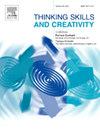融合六帽思维与人工智能:绿帽与ChatGPT如何共同调节职前教师的教学设计——来自认知网络分析的见解
IF 4.5
2区 教育学
Q1 Social Sciences
引用次数: 0
摘要
ChatGPT作为一款创新的ai驱动聊天机器人,在重新定义人机交互、增强教与学方面具有巨大的潜力。然而,目前的应用往往优先考虑功能效用而不是主动学习促进,使其在促进协作知识构建和元认知调节方面的作用缺乏实证研究。为了解决这一差距,本研究将ChatGPT整合到职前教师的协作学习经验中,利用六顶思考帽思维策略来支撑教学设计任务。本研究采用结合共调控编码和认知网络分析(ENA)的混合方法,比较了使用ChatGPT和六顶思考帽策略的群体与单独使用六顶思考帽策略的群体的共调控过程和焦点模式。结果表明,chatgpt辅助组在评估方面表现出强化的共同监管重点,同时对任务理解和内容监控的关注也显著提高。这些发现不仅阐明了ChatGPT在教师教育中的变革作用,还为教育工作者设计人工智能增强的协作学习环境提供了可操作的见解。本文章由计算机程序翻译,如有差异,请以英文原文为准。
Fusing Six-Hat thinking with AI: How the Green Hat and ChatGPT Co-Regulate pre-service teachers' instructional design—insights from epistemic network analysis
As an innovative AI-driven chatbot, ChatGPT holds substantial potential to redefine human-computer interaction and enhance teaching and learning. However, current applications often prioritize functional utility over active learning facilitation, leaving its role in promoting collaborative knowledge construction and metacognitive regulation empirically underexplored. To address this gap, this study integrated ChatGPT into pre-service teachers' collaborative learning experiences, leveraging the Six Thinking Hats thinking strategy to scaffold instructional design tasks. Using a mixed-methods approach combining co-regulation coding and epistemic network analysis (ENA), this study compared the co-regulation processes and focus patterns of groups using ChatGPT with the Six Thinking Hats strategy versus those using Six Thinking Hats alone. Results indicate that ChatGPT-assisted groups exhibited intensified co-regulatory focus on Evaluation, along with significantly heightened attention to Task Understanding and Content Monitoring. These findings not only illuminate ChatGPT's transformative role in teacher education but also provide actionable insights for educators designing AI-enhanced collaborative learning environments.
求助全文
通过发布文献求助,成功后即可免费获取论文全文。
去求助
来源期刊

Thinking Skills and Creativity
EDUCATION & EDUCATIONAL RESEARCH-
CiteScore
6.40
自引率
16.20%
发文量
172
审稿时长
76 days
期刊介绍:
Thinking Skills and Creativity is a new journal providing a peer-reviewed forum for communication and debate for the community of researchers interested in teaching for thinking and creativity. Papers may represent a variety of theoretical perspectives and methodological approaches and may relate to any age level in a diversity of settings: formal and informal, education and work-based.
 求助内容:
求助内容: 应助结果提醒方式:
应助结果提醒方式:


